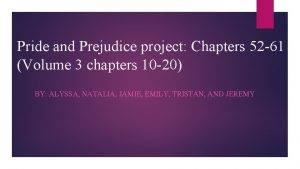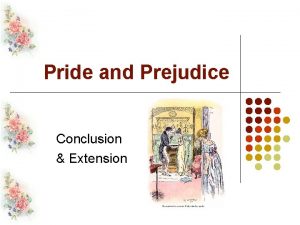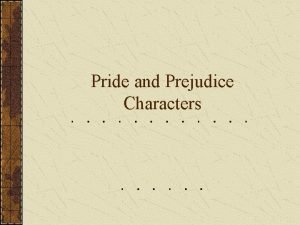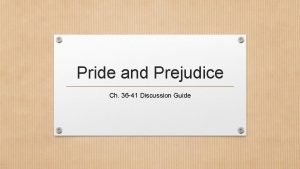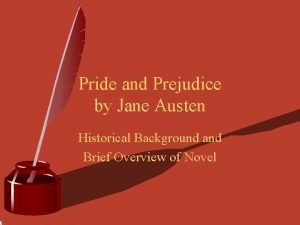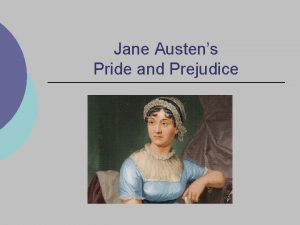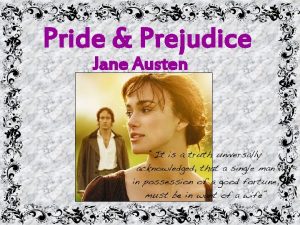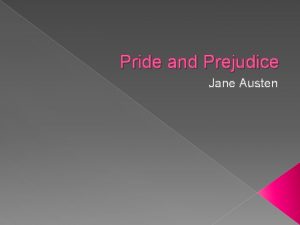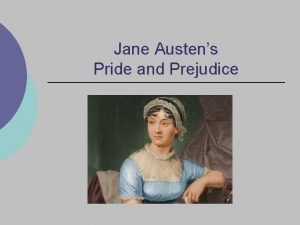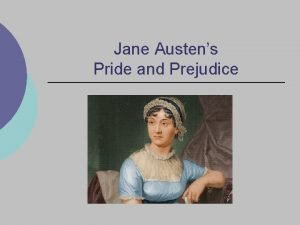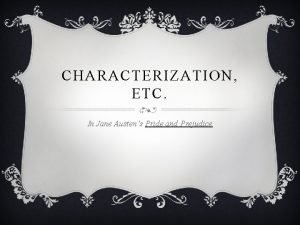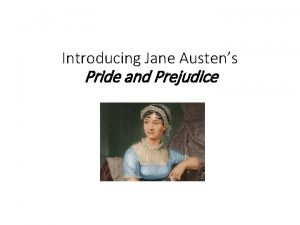Jane Austens Pride and Prejudice A Story of









- Slides: 9

Jane Austen’s Pride and Prejudice A Story of Love, Deception, Misunderstanding, and Sententious Twits

Jane Austen, 1775 -1817

The Move from Bath to Chawton

Chawton Cottage

Publication History of Pride and Prejudice The first draft, entitled First Impressions, completed in 1799 Published as Pride and Prejudice in January of 1813 A public and critical success, a second edition is ordered in October 1813 Still published anonymously

Famous First Lines “It is a truth universally acknowledged, that a single man in possession of a good fortune, must be in want of a wife. However little known the feelings or views of such a man may be on his first entering a neighbourhood, this truth is so well fixed in the minds of the surrounding families that he is considered as the rightful property of some one or other of their daughters. ”

Overview of Pride and Prejudice Elizabeth Bennet (Our pert and opinionated heroine) Jane Bennet (Her lovely sister, in love with Mr. Bingley) Lydia Bennet (Youngest Bennet sister, wild and unprincipled) Mr. Bingley (Rich, pleasant new man in the neighborhood, in love with Jane Bennet) Mr. Darcy (Bingley’s supercilious but ultimately good-hearted friend, admirer of Elizabeth) Caroline Bingley (Scheming and derisive sister of Bingley, in love with Mr. Darcy) Mr. Collins (Sanctimonious prig, inheritor of Bennet estate) Mr. Wickham (Handsome and manipulative rake) Lady Catherine de Bourgh (Irritatingly class-conscious and bossy aunt of Darcy) Georgiana Darcy (Innocent and ostentatiously helpless sister of Darcy)

Dancing in the Regency Period Most popular dances were the English Country Dance, the Cotillion, and the Scotch Reel These dances were bouncy and lively, with a group of couples lining up together and dancing as a whole and individually Note that the waltz wasn’t introduced until 1810, and this dance was generally considered “shocking” because the couples “embraced” each other Social class was extremely important in choosing partners

Nature vs. Nurture in Austen’s Works Austen, in keeping with the tradition of the “bourgeois” novel, is fascinated by the differences between breeding and character While retaining some emphasis on good breeding, Austen generally abandons the assertion that birth is the mark of character However, Austen also questions the role of influence, or upbringing, in Pride and Prejudice. She suggests that a person with a strong character can overcome an insufficient upbringing, while a weak character requires good influences, a solid education, and good examples
 Jane eyre pride and prejudice
Jane eyre pride and prejudice Irony dialogue
Irony dialogue Locations in pride and prejudice
Locations in pride and prejudice Volume 2 pride and prejudice
Volume 2 pride and prejudice Pride and prejudice volume 3 chapter 1
Pride and prejudice volume 3 chapter 1 Pride and prejudice chapter 52 summary
Pride and prejudice chapter 52 summary Pride and prejudice conclusion
Pride and prejudice conclusion Sir lucas kids in pride and prejudice
Sir lucas kids in pride and prejudice Pride and prejudice chapter 41 summary
Pride and prejudice chapter 41 summary Historical background of pride and prejudice
Historical background of pride and prejudice





